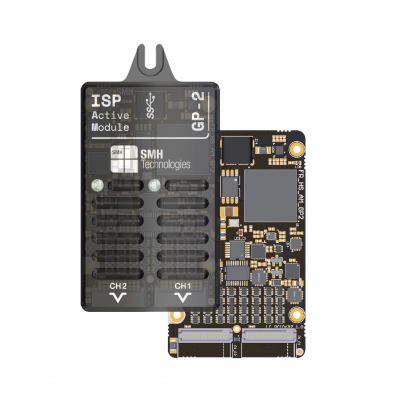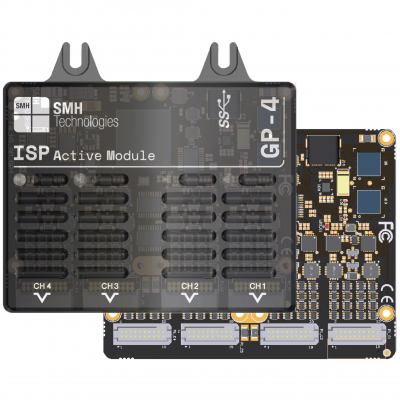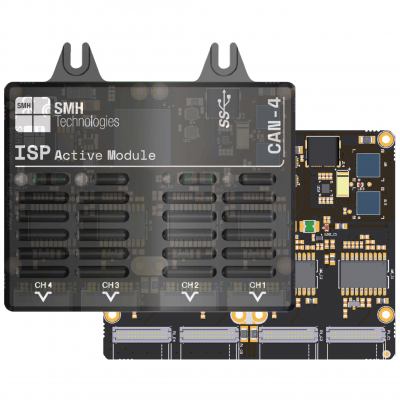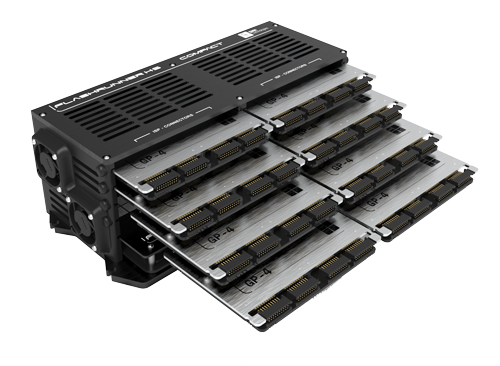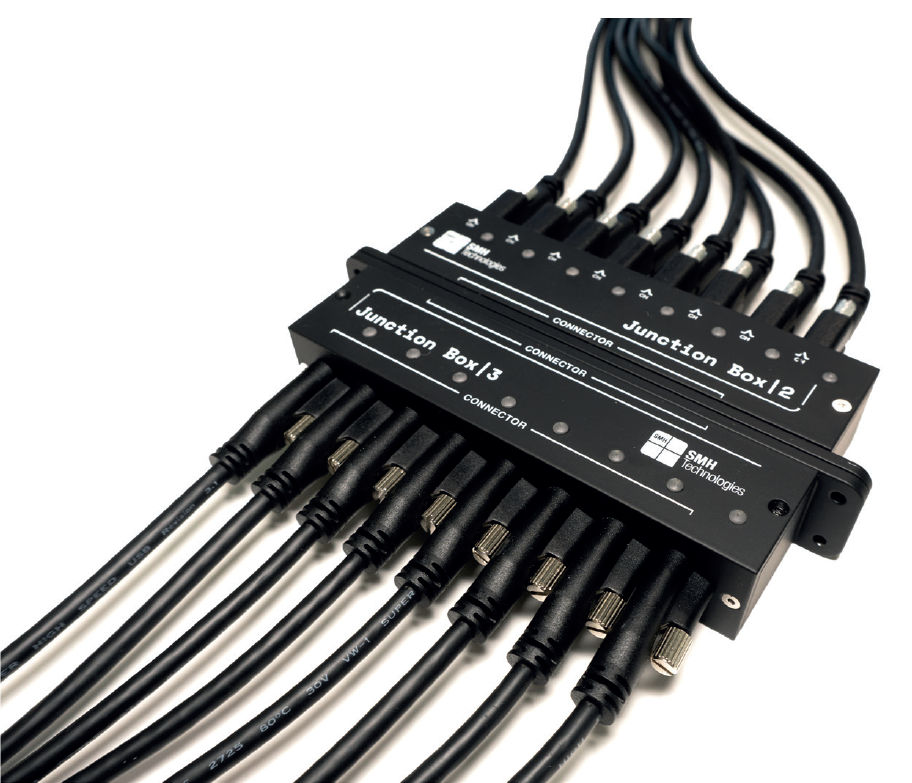FlashRunner High-Speed Control Unit
Universal FlashRunner High-Speed ISP programmer control unit controls active modules via the USB 3.1 interfaces. Provides data transfer rates up to 80MB / s. It is offered in two variants:
- FR-HS-CU4L – controls up to 4 modules (4 x USB 3.1)
- FR-HS-CU8L – controls up to 8 modules (8 x USB 3.1)
Technical specification:
- processor: Intel SOC FPGA with 800 MHz dual core ARM Cortex-A9
- memory: 1 GB RAM DDR3, 256 GB eMMC
- micro SD (up to 256 GB) reader
- 4/8-independant channels controlling active front-end modules – each can program different devices concurrently
- unit for integration in ATE
- dimensions: 170 x 83 x 19 mm
- communication with PC/ATE: LAN 1Gbps, digitaly optoizolated USB-UART, digitaly optoizolated parallel interface for ATE
- communication with active front-end modules: USB 3.1
- clock/calendar
- status and operation LEDs
- aesthetic woorkmanship
- software functionalities:
- device test
- watchdog
- encrypption and secure data transfer
- easy integration with ATE/LabView/CVI using DLL libraries
- overvoltage and undervoltage detection during programming
- serialization
- dynamic pinout management
- conditional erase
- on-line knowledge database
- operation counters, log files, production reports
- project wizards
- user permission management
- new, user friendly GUI
FlashRunner High-Speed General Purpose Active Modules
Front-ends of the universal FlashRunner High-Speed ISP programmer, controlled via USB 3.1 interfaces and type C connector from the control unit. Made in the form of micromodules, they can be installed directly next to the programmed devices, reducing the transmission cables of high-speed signals to a minimum. Thus, they ensure the appropriate quality of the waveforms on the pins of the programmed devices.
- general purpose modules (for microcontrollers, serial memories, CPLD and OTP circuits) 1, 2 or 4 channels
- optional relay barriers
- available variants are marked with catalog numbers as follows:
- AM-GPx-rr
- x – number of channels (1, 2, 4);
- rr – extension:
- CS – case
- OF – open frame
- RB – relay barrier
- AM-GPx-rr
- small dimensions: i.e. 66 x 40 x 9 mm
- protocols: eMMC, NAND, BDM, JTAG, DAP, CSI, SPI, QUAD-SPI, I2C, UART, MC2W, ISSP, SWD, ICSP, EICSP, MDI, PPM, PDI, SWIM, …
- 8 I/O lines (4 ground lines)
- innovative cutting-edge, quick line drivers
- 2 independent and programmable voltage lines for each channel
- relays command management and relays power supply
- communication frequency towards device up to 50 MHz
- output power lines voltage and current monitoring
- status LEDs for each channel
- 20 positions vertical or right-angle connector for each channel to connect target system directly or indirectly - using relay barriers
FlashRunner High-Speed Active Modules for eMMC Memories
Front-ends of the universal FlashRunner High-Speed ISP programmer, controlled via USB 3.1 interfaces and type C connector from the control unit. Made in the form of micromodules, they can be installed directly next to the programmed devices, reducing the transmission cables of high-speed signals to a minimum. Thus, they ensure the appropriate quality of the waveforms on the pins of the programmed devices.
- modules for eMMC memories programming; 1 or 2 channels
- optional relay barriers
- available variants are marked with catalog numbers as follows:
- AM-eMMCx-rr
- x – number of channels (1, 2);
- rr – extension:
- CS – case
- OF – open frame
- RB – o relay barrier
- AM-eMMCx-rr
- small dimensions: i.e. 66 x 40 x 9 mm
- 12 I/O lines (6 ground lines) supporting 8-bit eMMC interface
- innovative cutting-edge, quick line drivers
- 2 independent and programmable voltage lines for each channel
- relays command management and relays power supply
- high-speed data transfer to programmed dwvice up to 80MB/s
- output power lines voltage and current monitoring
- status LEDs for each channel
- 20 positions vertical or right-angle connector for each channel to connect target system directly or indirectly - using relay barriers
FlashRunner High-Speed Active Modules for NAND Memories
Front-ends of the universal FlashRunner High-Speed ISP programmer, controlled via USB 3.1 interfaces and type C connector from the control unit. Made in the form of micromodules, they can be installed directly next to the programmed devices, reducing the transmission cables of high-speed signals to a minimum. Thus, they ensure the appropriate quality of the waveforms on the pins of the programmed devices.
- Single channel module for NAND memories
- optional relay barriers
- available variants are marked with catalog numbers as follows:
- AM-NAND1-rr
- rr – extension:
- CS – case
- OF – open frame
- RB – o relay barrier
- AM-NAND1-rr
- small dimensions: i.e. 66 x 70 x 9 mm
- 24 I/O lines (12 ground lines) supporting 8- and 16-bit NAND memories
- innovative cutting-edge, quick line drivers
- 2 independent and programmable voltage lines for each channel
- relays command management and relays power supply
- high-speed data transfer to programmed device up to 80MB/s
- output power lines voltage and current monitoring
- status LEDs for each channel
- 20 positions vertical or right-angle connector for each channel to connect target system directly or indirectly - using relay barriers
FlashRunner High-Speed Active Modules for CAN Devices
Front-ends of the universal FlashRunner High-Speed ISP programmer, controlled via USB 3.1 interfaces and type C connector from the control unit. Made in the form of micromodules, they can be installed directly next to the programmed devices, reducing the transmission cables of high-speed signals to a minimum. Thus, they ensure the appropriate quality of the waveforms on the pins of the programmed devices.
- 4-channels module for CAN devices
- optional relay barriers
- available variants are marked with catalog numbers as follows:
- AM-CAN4-rr
- rr – extension:
- CS – case
- OF – open frame
- RB – o relay barrier
- AM-CAN4-rr
- small dimensions: i.e. 66 x 80 x 9 mm
- innovative cutting-edge, quick line drivers
- 2 independent and programmable voltage lines for each channel
- relays command management and relays power supply
- high-speed data transfer to programmed device up to 12Mb/s
- output power lines voltage and current monitoring
- status LEDs for each channel
- 20 positions vertical or right-angle connector for each channel to connect target system directly or indirectly - using relay barriers
FlashRunner HS Compact
The scalable rack up to 32 channels, for active FlashRunner high-speed modules for parallel ISP programming of multiple systems using a wide range of protocols. It is an additional accessory for FlashRunner Hig-Speed technology programmers, facilitating the mechanical installation of modules in the system. The cassette is characterized by small dimensions of 193 x 89 mm with four available heights of 36/46/56/66 mm for 2/4/6/8 modules. The installed active modules are controlled by the FlashRunner High-Speed main control unit located at the bottom of the cassette.
FlashRunner High-Speed Relay Barriers
The relay barrier is an additional board that can be plugged into the Active Module and it allows the customer to galvanically isolate the target board from the FlashRunner when the programming is completed.
There are two models of relay barrier:
- Single-channel with 30-pin connector, for eMMC, NAND, Octo-SPI;
- Double-channel with 20-pin connectors, for General Purpose or CAN Active Modules.
With these two options, it is possible to have a relay barrier integration for all active modules currently available.
FlashRunner High-Speed Junction Boxes
To easily and quickly change accessories in the programming station without unscrewing 4/8 of the USB cables, special junction boxes are available for switching from USB cables or connectors that can be easily disconnected. This allows the ICT tester/ISP programmer cassettes to be replaced in one move. The junction boxes thus simplify the mechanical design of the testers/programmers. And so:
- FR-HS-JB1 – is an adapter connected directly to the USB connectors of the central unit
- FR-HS-JB2 – is an adapter connected to the central unit via USB cables
- FR-HS-JB3 – is an adapter connected to the active module via USB cables
Junction boxes are used as an intermediate interface between the central unit and active modules. Boxes are used in pairs. Always one of the JB1 or JB2 adapters cooperates with one JB3 adapter. They are easily detachable, so they allow easy disconnection/connection of the tester/programmer cassette containing the active modules from/to the cassette containing the control unit. Thus, they enable easy replacement of the tester/programmer cassette containing active modules with another one - according to the change of the programmed PCB.
FlashRunner High-Speed Algorithms
Licenses for the programming algorithms are offered separetly. The programming algorithms are dedicated to individual active modules and are marked with the following catalog numbers:
- PAmmmmPPPP
- mmmm – type of active module (GP1, GP2, GP4, CAN4)
- PPPP – type of software package/algorithms (STD0, NMM0, STP05, STP10, STP15, FPK0, SCP0, GEN0)
They are offered in the following packages:
- Single algorithms:
- PAmmmmSTD0 - a single algorithm for a standard device - commonly used on the market
- PAmmmmNMM0 - a single algorithm for a "non-standard" device - rarely used on the market
- Credits for the purchase of algorithms to be used within one year from the date of purchase:
- PAmmmmSTP05 - 5 algorithms of free choice for standard circuits
- PAmmmmSTP10 - 10 algorithms of free choice for standard systems
- PAmmmmSTP15 - 15 algorithms of free choice for standard systems
- Algorithm packages:
- PAmmmmGEN0 - algorithms for all currently supported standard devices from all semiconductor suppliers
- PAmmmmSCP0 - algorithms for all currently implemented standard devices from one selected semiconductor vendor
- PAmmmmFPK0 - algorithms for all currently implemented standard devices of one selected devices’ family
System software is also available, which can be downloaded from the manufacturer's website (icon in the right margin).






